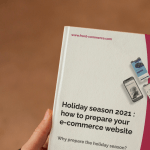Peak shopping seasons provide shops, retailers and brands with their biggest sales opportunities of the year. But even the slightest error might have a disastrous effect on turnover. Businesses need to perform their best during their biggest seasons, whether that’s Black Friday, back-to-school season, Valentine’s Day or Christmas.
A large source of tension for many retailers during this period is their e-commerce architecture. With a traditional monolithic architecture, if one component or system goes down, it will likely take the rest down with it. Website updates can also be hard and scaling can be a real challenge. Headless commerce can help with that. By decoupling the frontend and backend, and connecting different systems through API, flexibility, adaptability, speed and performance are ensured and optimized.
Let’s go over just how headless commerce can help you scale during peak shopping seasons.

Not sure what Headless commerce is?
Why scaling during peak is essential
During peak shopping seasons, your e-commerce site is likely to have a considerable increase in visits, page views and transactions. If your systems are not ready, your site can crash and you can miss out on a huge number of sales. Even the largest retailers with sophisticated ecommerce setups struggle with the difficulty of scaling to meet peak demand in order to assure optimal performance and avoid website disruptions.
Unfortunately, this problem is often in the news. We’ve all heard the horror stories of retailers whose websites collapsed on Black Friday for hours at a time or whose sites were so slow that customers were unable to shop. And it’s not only in the headlines; customers often vent their annoyances on social media. Your brand will quickly become popular, but not for the right reasons.
Before peak starts, you need to ensure that every part of your e-commerce system, from the website itself to payments, logistics, carriers, advertisements, warehouses and servers, are running smoothly and are ready for a big influx of orders.
With Headless Commerce, problem resolution is faster and simplified
One of the biggest issues retailers face with peak is the overload of certain systems, networks or third-party services. Not only that, but it is sometimes hard to know where the source of the problem is. Precious hours can be lost just looking for the source of the problem before even starting on finding a solution to fix it. With headless, this problem can be significantly reduced. As the architecture is decoupled, identifying, isolating and fixing the problem is significantly easier.
For example, at Front-Commerce, as a headless frontend solution, in case of a problem or issue, we are able to analyze the root cause to help our client identify which third-party service is failing. This analysis and alert is then directly transmitted to the relevant people at our client’s company. So, essentially, when we detect an issue, we don’t simply check that the issue is not on our end. We take it a step further to help the e-retailer and the tech team to identify and solve the problem at the right place. As frontend experts, we take a closer look when things are not going well, we bring qualified and precise information on the application code that is causing problems, and we can even go as far as to suggest a quick fix.
In decoupled architectures, it also is possible to deliver a slightly different and lighter experience to users in case a system or 3rd party service is slow or unresponsive. For instance, if the “Customer Reviews service” is slow, it is possible to display a product detail page without customer reviews. That’s an additional way to maintain good SLA without sacrificing the core of the business (i.e: suggesting products and allowing customers to buy them).
Error detection and display adaptation are made quicker and easier to resolve thanks to the headless architecture.

How to migrate from a monolith to headless commerce
Better performance thanks to a Headless Commerce approach
By separating your frontend from your backend systems, which is essentially what headless commerce is, you can scale your web experience independently of your backend systems. To make sure you can handle peak loads, a strong sales and traffic prediction is also necessary. A year-on-year comparison is a wonderful place to start, but it’s also crucial to take special circumstances like new websites, specials, and promotions into account. For example, Front-Commerce not only hosts your frontend but also offers an unlimited auto-scaling feature that automatically adapts to increased traffic loads within seconds.
Better performance also hinges on proper monitoring. Your capacity to quickly fix a problem if performance does decline or your site goes down depends on the data you have and how quickly you can delve deeper. Real-time, 24/7 user monitoring is essential during the busiest shopping times, and traceability tracking throughout the web storefront and other back-end systems is essential.
There are also other ways a headless approach can enhance performance. Let’s say you opt for a headless PWA frontend. In that case, a PWA frontend will allow you to enable extensive caching capabilities. The key to reducing bottlenecks is proper cache usage at the CDN and frontend application level. A CDN (Content Delivery System) offers many layers of caching at strategic locations. The need to hit backend systems while they are already under stress is reduced by using a CDN, which also enables you to maintain stability across all touchpoints. Thanks to this, you can optimize the traffic hitting your origin server during peaks so that only transactional actions lead to load in your systems. In a sense, your load is proportional to your turnover!

